
Guided tour of the Abbey Library, the Cathedral and the Old Town of St. Gallen
Duration: 1:30 hours

8 Activities
Filter
Better than 4.5 stars
Better than 4 stars
Better than 3.5 stars
Better than 3 stars
No Rating

Duration: 1:30 hours

Duration: 5 hours
Why book with Swiss Activities?

Duration: 2 hours

Duration: 2 hours

Validity: All day

Duration: 1 hour

Duration: 1 hour

Duration: 1 hour
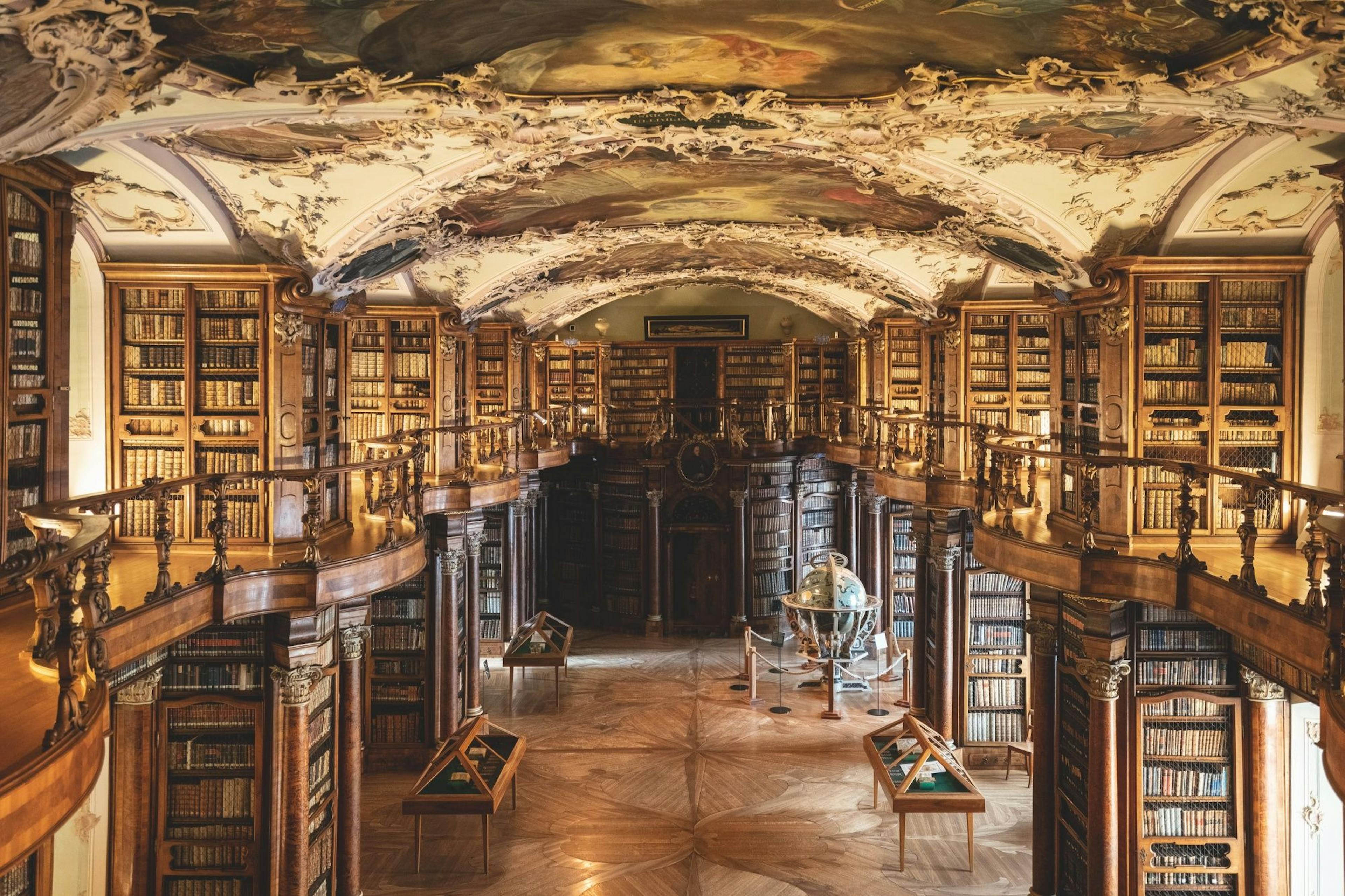
Tour
High demandDuration: 1:30 hours
booked 167 times

Tour
High demandDuration: 5 hours
booked 23 times
Why book with Swiss Activities?

Games
Duration: 2 hours
booked 11 times
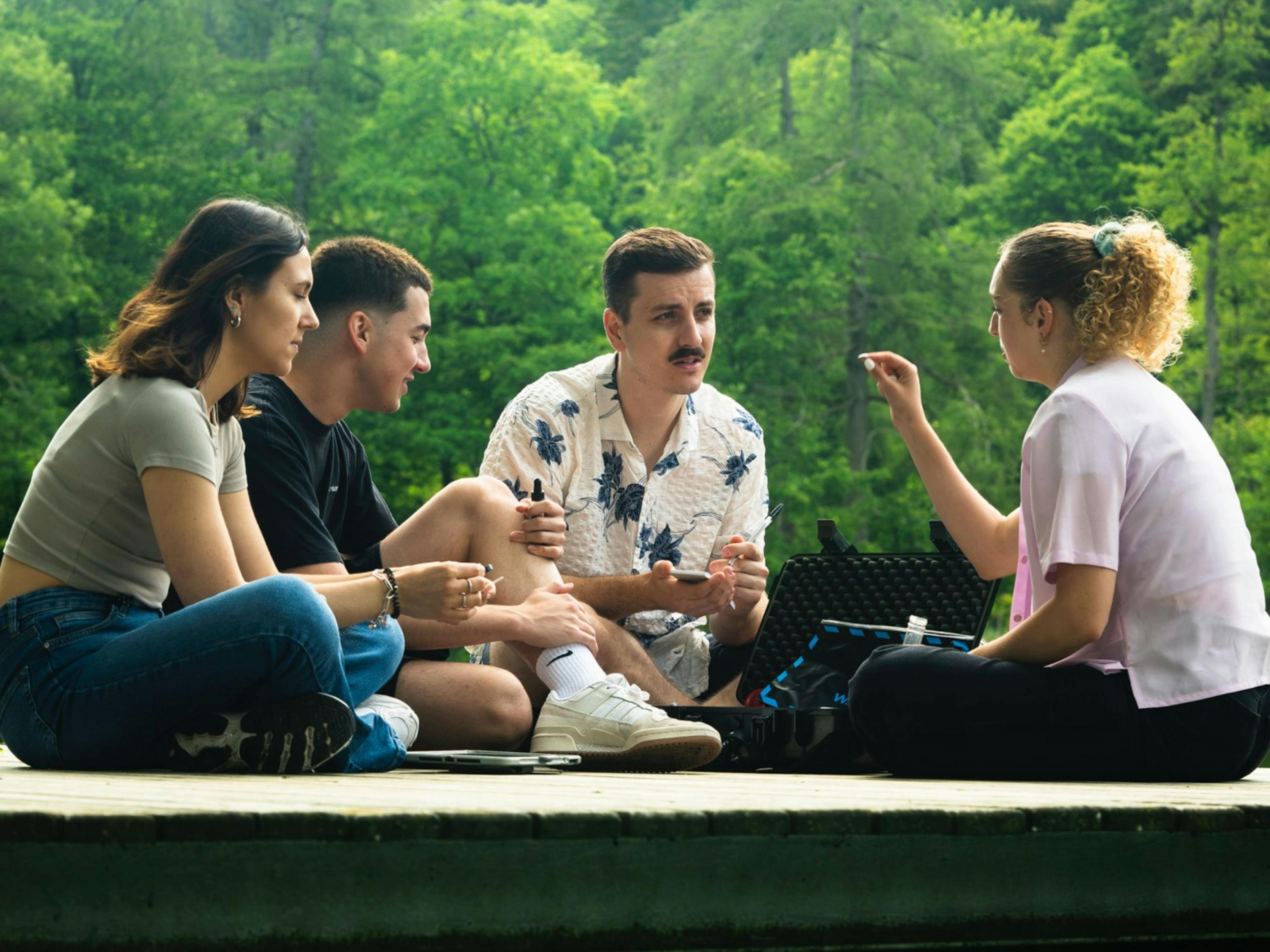
Games
Duration: 2 hours
booked 8 times

Games

Games
Duration: 1 hour
booked 6 times

Games
Duration: 1 hour
booked 5 times

Games
Duration: 1 hour
booked 5 times
London, Paris, New York, Toronto, Buenos Aires… The list of cities built by the water goes on and on.
Most Swiss cities were also developed with this principle in mind, often located right next to a body of water. Whether it's Lucerne on the Lake Lucerne, Basel on the Rhine, Bern on the Aare, or Geneva by the Lake Geneva.
But as the saying goes, there's no rule without an exception. And that's exactly what this article is about—an often overlooked but equally beautiful city in eastern Switzerland.
St. Gallen is located about 70 km east of Zurich and, with around 75,000 residents, it is the eighth largest city in Switzerland. It’s known for various things, including the University of St. Gallen (HSG), its rich history in the textile industry, and the UNESCO-listed abbey district surrounding the baroque cathedral.
In addition, St. Gallen is perfectly positioned between Lake Constance and the Alpstein mountain range, making it ideal for active day trips, and there are plenty of charming spots to explore within the former city walls. There are more than enough reasons to pay this city a visit.
The landmark of the city of St. Gallen is undoubtedly found in the Abbey District, which has been a UNESCO World Heritage Site since 1983. In this district belongs in the first place the dominant baroque cathedral, which was built in the middle of the 18th century and can be visited free of charge throughout the year.
With its two imposing towers and magnificently decorated interior, it is more than worth a visit.
Also part of the Abbey District is the Abbey Library. It is home to about 170,000 books, some of which are well over 1,000 years old. But not only old books can be viewed in this enchanting hall. A mummy that is over 2,700 years old has also found its way into the library and finds its final peace here between the shelves.
Her name is "Schepenese" and you will find out how she got from Egypt to St. Gallen during your visit to the museum. Detailed information on the Abbey District are interesting for this important area of the city of St. Gall, should you wish to explore it beyond the obligatory photo of the cathedral.
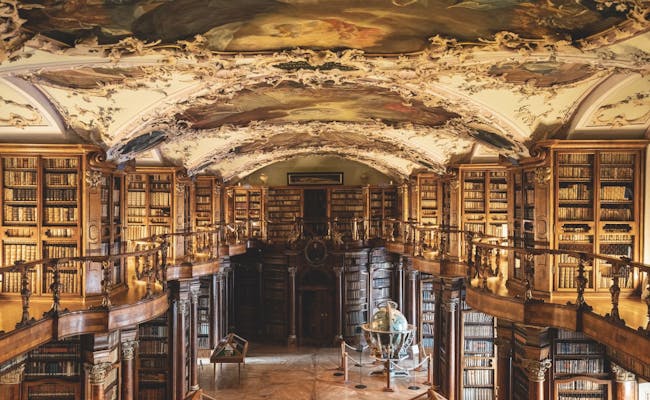 (Photo: Switzerland Tourism Andre Meier)
(Photo: Switzerland Tourism Andre Meier)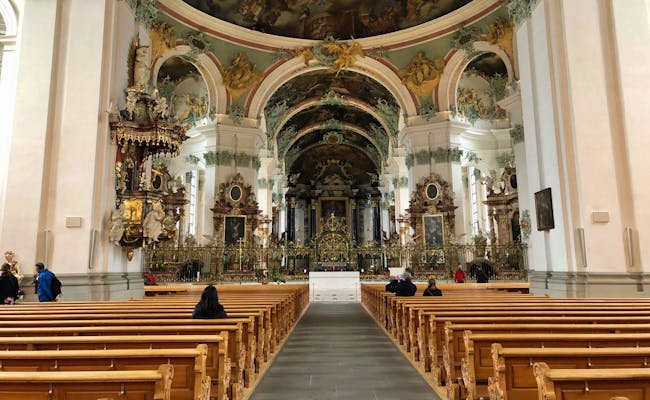 (Photo: Seraina Zellweger)
(Photo: Seraina Zellweger)When it comes to colorful interior design, no other church in St. Gallen can hold a candle to the Laurenzenkirche. The walls are decorated in all imaginable colors and even the roof, which you can admire best in combination with a tower climb, consists of a colorful mosaic.
Outside the winter months, the Laurenzenkirche can be climbed twice a day - at 10:00 and at 15:00. The 186 steps are quite strenuous, but you will be rewarded with a wonderful view over the Stiftsbezirk and the city of St. Gallen.
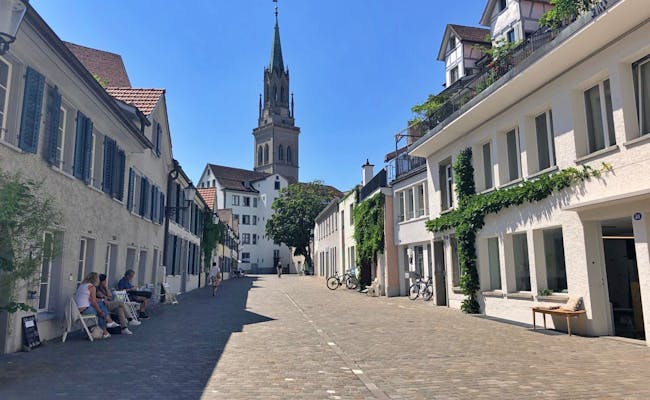 The tower of the Laurenzen Church can be climbed.
The tower of the Laurenzen Church can be climbed.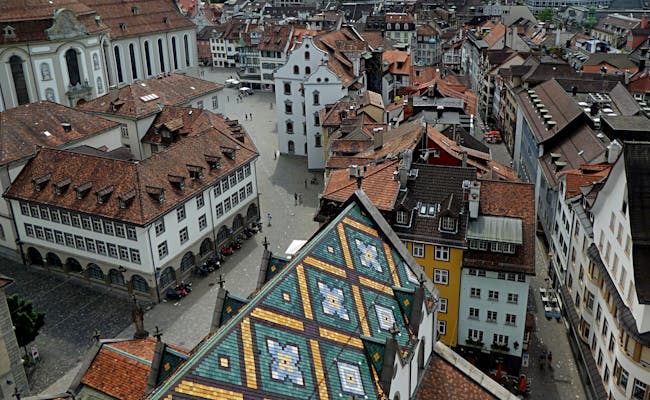 Do you recognize the colorful roof of the Laurenzenkirche?
Do you recognize the colorful roof of the Laurenzenkirche?Hardly any other square in the city of St. Gallen is as inviting and charming as Gallusplatz. Since 2012, it has shone in new splendor and, thanks to the redesign with benches and trees, invites you to linger. It is the perfect place to pause for a moment, watch the people passing by from the rondelle, enjoy a delicious ice cream from the nearby Chocolaterie Kölbener and watch the colorful hustle and bustle of the city.
The cathedral and the Abbey Library are immediately adjacent to Gallusplatz. So you have no excuse to skip this place during your visit 🙂
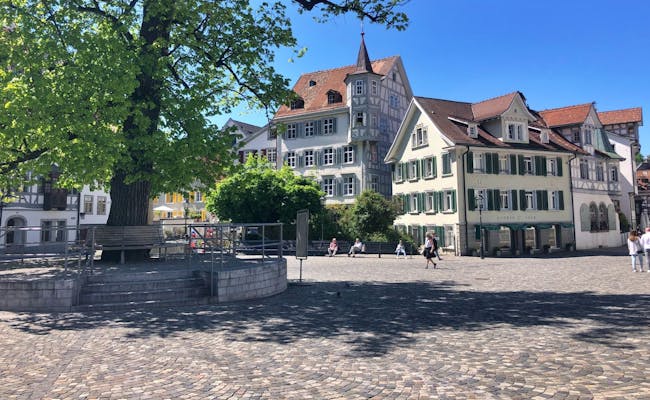 Gallusplatz: One of the most beautiful squares in the city of St. Gallen
Gallusplatz: One of the most beautiful squares in the city of St. Gallen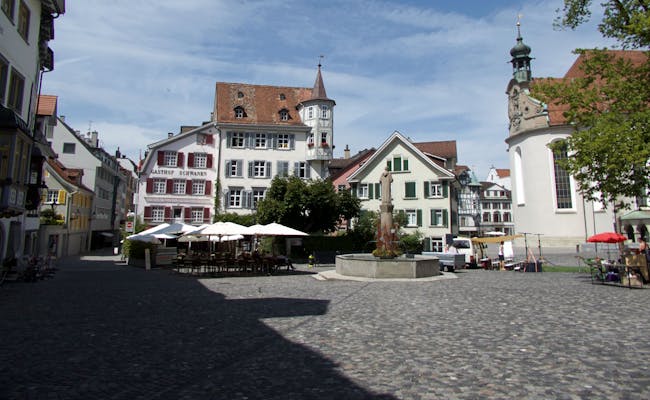 The Gallusplatz from a different perspective
The Gallusplatz from a different perspectiveAlthough St. Gallen is not located at a well-known body of water, the city does not have to completely do without the cool wet. The extremely popular recreation area "Drei Weieren", directly above the old town, offers various possibilities to linger, swim, walk, play soccer, read, picnic or just enjoy the view.
The Drei Weieren, which actually consist of five ponds, were originally built as a water reservoir for the textile industry in the 17th century. But they were also intended to supply the fire brigade with sufficient water in the event of a city fire.
Swimming is only allowed in two of the five ponds - Mannenweier and Frauenweier. The Mannenweier is free and open to the public, while the Frauenweier is an open-air swimming pool with an extended infrastructure, for which a fee is charged.
Whether you're looking for a wet cool-down, or just a beautiful view over the city of St. Gallen and Lake Constance as far as Germany, a stop at the Drei Weieren is a must in any case.
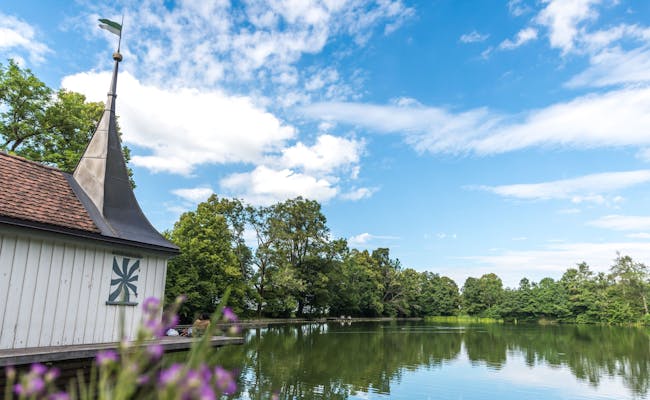 Recreational area of St. Gallen (Photo: Lake Constance Tourism)
Recreational area of St. Gallen (Photo: Lake Constance Tourism)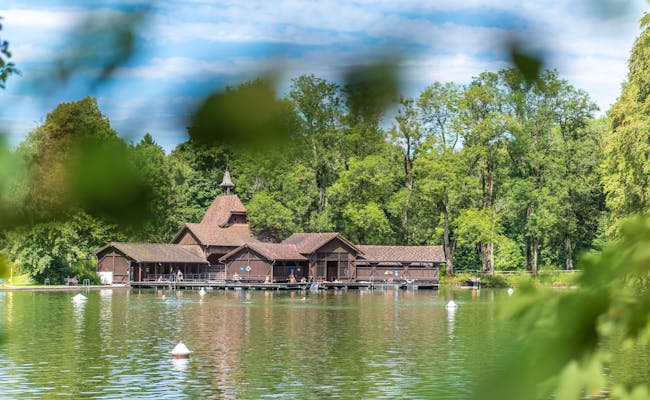 (Photo: Lake Constance Tourism)
(Photo: Lake Constance Tourism)Swiss Activities Tip No. 1: The Drei Weieren can be perfectly combined in an approx. one-hour walk from the abbey district to the Notkersegg monastery. On the way, two farms await you, selling fresh produce directly from the farm. The assortment includes cheese, fresh milk from the vending machine, eggs, apple juice, meat, fresh berries depending on the season and much more.
Swiss Activities Tip No. 2: When the weather is nice in summer, the Bäderbus runs free of charge between the city of St. Gallen and the Drei Weieren. It is best to wait for the bus at the train station or at the bus stop Marktplatz.
The Mülenen Gorge is considered the birthplace of the city of St. Gallen. According to legend, the Irish wandering monk Gallus fell into a thorn bush at the foot of the gorge. He interpreted this incident as a sign from God to stay in this place and so the city was born in this valley along the river Sitter.
The Mülenen Gorge leads just behind the Abbey district up to the St. Georgen district, where the Drei Weieren are also located. On foot you need about 10 to 15 minutes to reach the top of the gorge. On the way, various information boards await you, which explain the history of this place in more detail.
In addition, one of the paths leads over a bridge in front of the town's own waterfall, which, depending on the rainfall of the past few days, can be a considerable force of nature.
Swiss Activities Tip: In spring, the hillside next to the waterfall is overgrown with tons of wild garlic. If you want to spice up your cooking a bit this time of year, help yourself unabashedly here. But be careful: Wild garlic is not to be confused with the poisonous lily of the valley, which looks deceptively similar. Make sure you know how to tell the two apart via this article on confusing wild garlic.
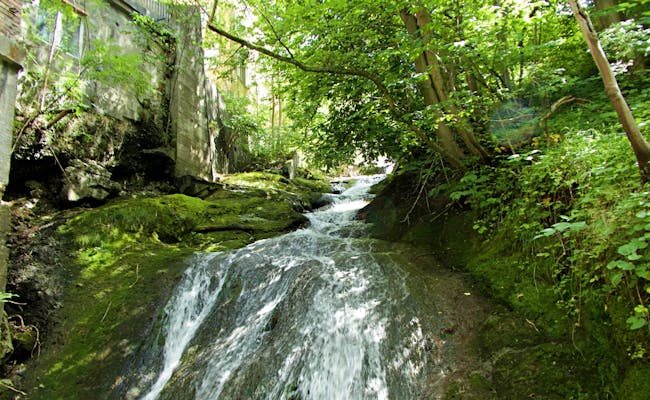 Waterfall at the Mühlenenschlucht
Waterfall at the Mühlenenschlucht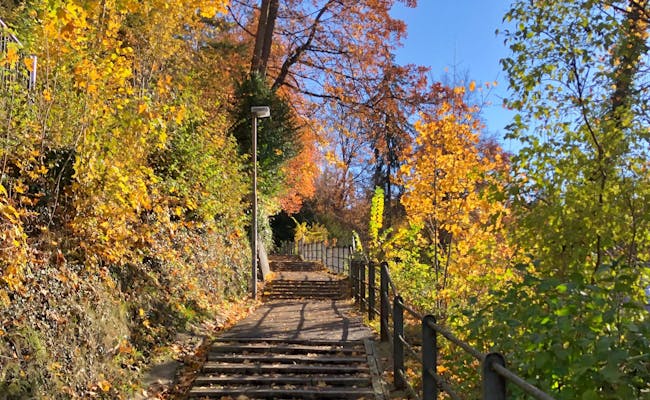 (Photo: Seraina Zellweger)
(Photo: Seraina Zellweger)Of course there is a convenient alternative to overcome the almost 70 meters in altitude between Mühlegg and St. Georgen.
The Mühleggbahn was built in 1893 as a water weight railroad. The city of St. Gallen converted it to a rack railroad in 1950 and to a funicular in 1975. The railroad runs regularly on demand between the Mühlegg and St. Georgen and is integrated in the zonal tariff of the city of St. Gallen.
The ride takes a little more than a minute and leads through a tunnel, which means that the view of the Mülenen Gorge is very limited. However, if the steep path or the many steps to St. Georgen scare you off, the Mühleggbahn is just the thing for you.
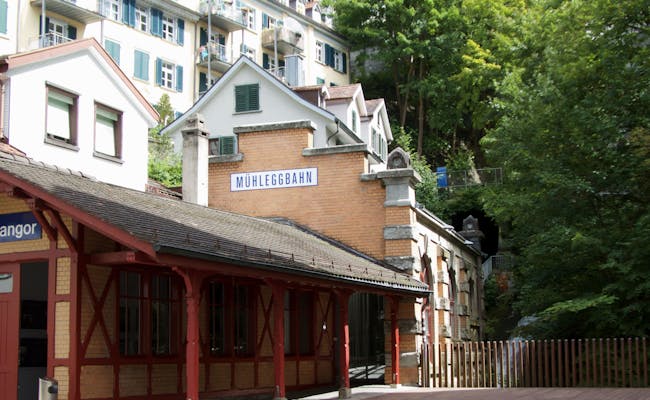 Mühleggbahn Station
Mühleggbahn Station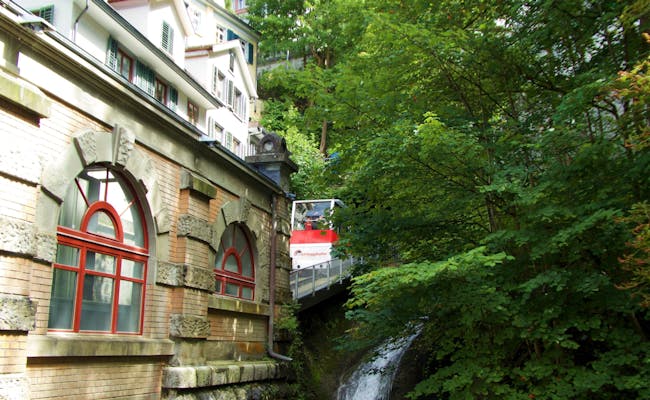 2 minutes to St. Georgen by train
2 minutes to St. Georgen by trainSpeaking of stairs..
Since St. Gallen is located in a valley and it is partly steep up the slope in the north and south, the city is equipped with plenty of stairs. And by plenty, I really mean plenty.
According to the website "Stägestadt", there are about 13,000 stairs. More than enough to give your thighs a little workout
A clear advantage of the many stairs is the direct access to the higher quarters. Within a short time you gain height and get a good overview of the city. Should you ever get lost, you will soon find your bearings again thanks to the many stairs
Most of the stairs are open to the public, even if it may not always look like it. However, if you should catch a private staircase, you will notice it at the latest when you are standing in front of a building entrance and can't get any further
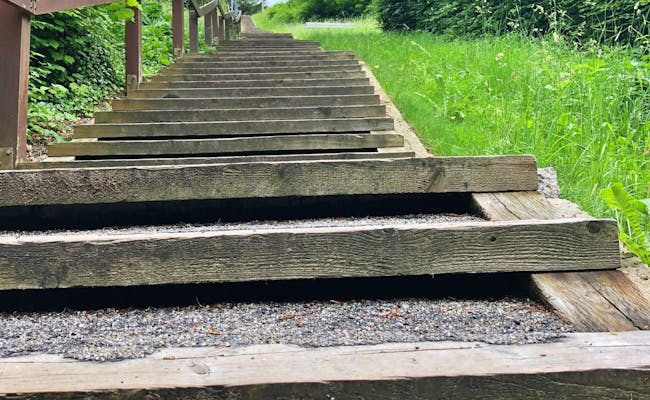 No matter where you are. The next staircase is not far away.
No matter where you are. The next staircase is not far away.In the northeastern part of the city of St. Gallen is the Wildpark Peter & Paul. A walk through the world of fallow deer, wild boars, ibex, chamois, marmots and many other animals is free of charge and is perfect if you want to get an idea of the Swiss fauna.
By the way, the view over the city of St. Gallen and into the Alpstein mountains is not to be sneezed at from the game park either.
The most direct way to the Peter & Paul is by bus number 5 in the direction of "Rotmonten" or by bus number 9 in the direction of "Schuppis Nord". After the bus stop "St. Gallen, Sonne" you only have to follow the signs with the label "Wildpark".
Swiss Activities Tip: The Wildpark Peter & Paul is part of a local recreation area, through which countless hiking trails lead. From here, you can continue in any direction should you have the urge for a longer hike after walking through the wildlife park. One of my favorites is the trail to Wittenbach, which eventually continues to Lake Constance. For a detailed overview of your options, check out the interactive map from Schweizmobil.
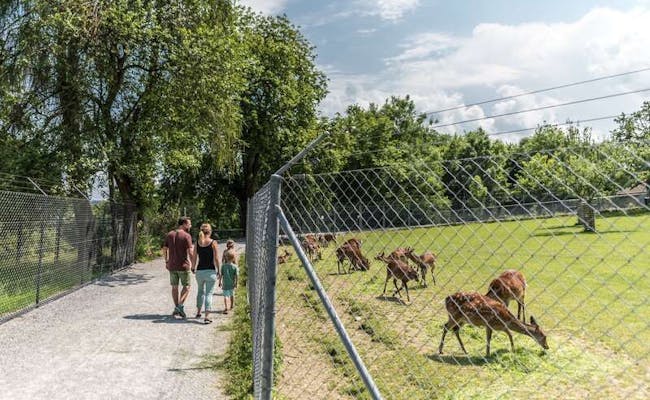
 (Photo: MySwitzerland)
(Photo: MySwitzerland)Another advantage of St. Gallen's exceptional location is that the comparatively narrow but long city has large points of contact with nature on two edges. As already mentioned in connection with the stairs, the city lies to the north and south on a slope and then merges into extensive natural landscapes.
So it is irrelevant where in the city of St. Gallen you are. You are hardly more than 10 minutes away from a walk in the fresh green.
And I don't just mean classics like the Drei Weieren or the Wildpark Peter & Paul. The Berneggwald forest above St. Georgen, which with its many squirrels, deer and wood mice is one of my favorite destinations after work, is only a short but steep walk from the city center.
Swiss Activities Tip: If you're looking for a walk in nature but don't know where to go, just march. Follow the first staircase you find and be surprised where it takes you. By the time you reach the top, you'll have a beautiful view over the city and have found your bearings again. To avoid getting lost, you can look for the cathedral as a reference point.
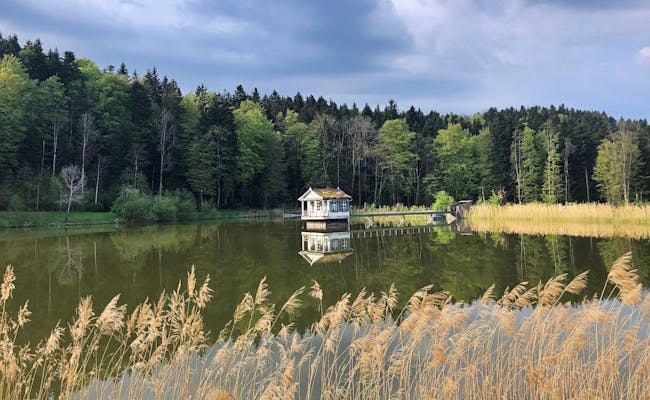 The Wenigerweier near St. Gallen (Photo: Seraina Zellweger)
The Wenigerweier near St. Gallen (Photo: Seraina Zellweger)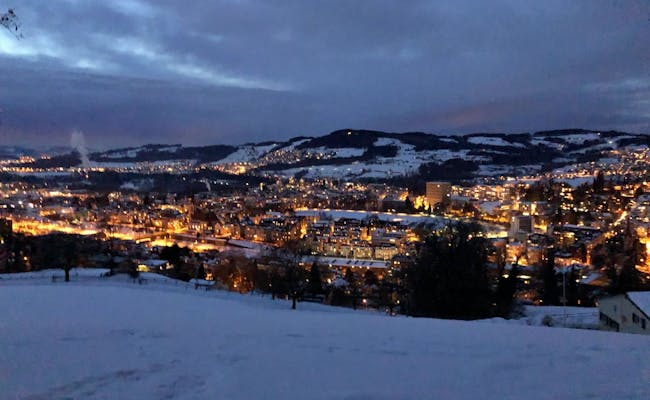 Walking in St. Gallen in Winter (Photo: Seraina Zellweger)
Walking in St. Gallen in Winter (Photo: Seraina Zellweger)A somewhat larger walk right on the outskirts of the city of St. Gallen deserves a separate mention here.
The course of the river Sitter, which flows around the city from west to north, is almost littered with bridges and viaducts. That's why the bridge trail was created and signposted, which takes you past 18 viaducts, wooden and concrete bridges, and wooden footbridges. You cross some of them, others you see from a distance or you pass under them. For example, the Sitter Viaduct, the highest railroad bridge in Switzerland.
The hike Bridge Trail St Gallen takes about 2 hours and starts at the Haggen-Schlössli above the Sitter.
On the way you will pass several picnic areas and have the possibility to take a refreshing bath in the river Sitter. If you have enough time, plan half a day for this excursion and don't forget your swimming trunks and food.
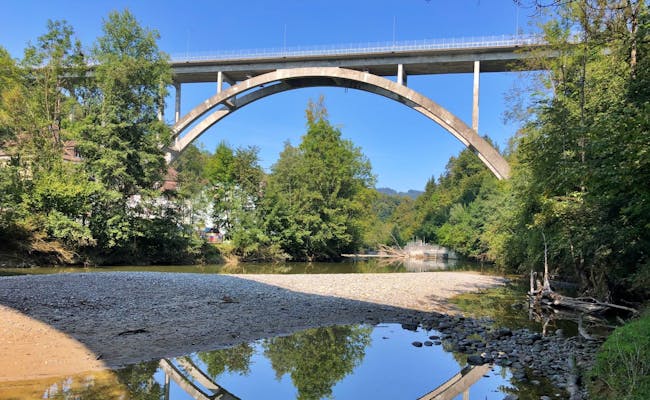 The St. Gallen Bridge Path leads past 18 bridges, viaducts, and wooden walkways.
The St. Gallen Bridge Path leads past 18 bridges, viaducts, and wooden walkways.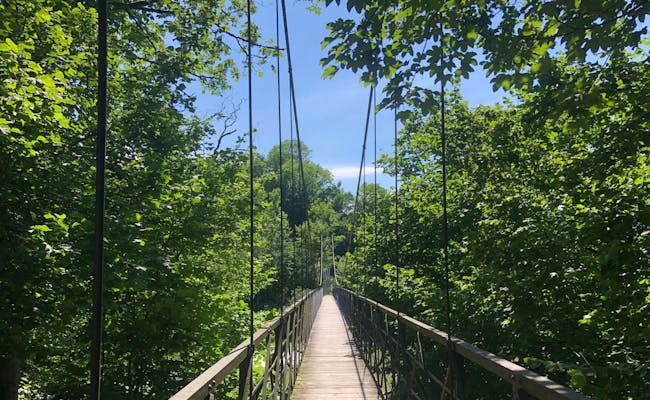 (Photo: Seraina Zellweger)
(Photo: Seraina Zellweger)Botanists and plant fans will get their money's worth at the botanical garden of the city of St. Gallen. It displays over 8000 labeled plants from all over the world, which can be explored either on an individual visit or as part of a public or private guided tour.
Bus number 1 in the direction of Stephanshorn will take you to the "Naturmuseum" stop, which is the closest stop to the botanical garden, which is open to the public free of charge.
 Botanical Garden: Over 8,000 plants from around the world
Botanical Garden: Over 8,000 plants from around the world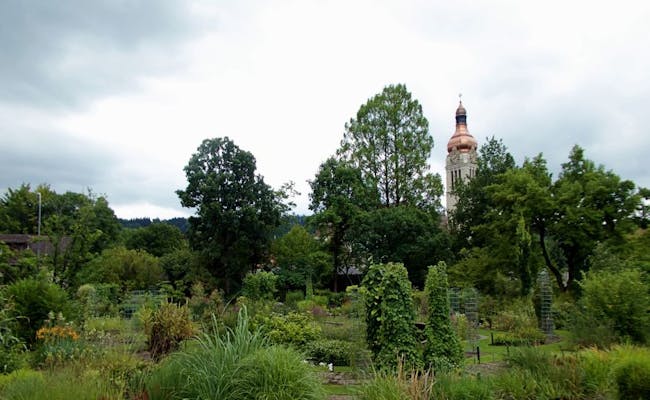
Did you know that St. Gallen has an impressive and long textile history to tell? The region was once one of the world's most important and largest manufacturing and exporting areas of embroidery products. To this day, St. Gallen remains a central player in the textile industry. Celebrities such as Lady Gaga and Michelle Obama wear products made by textile companies from eastern Switzerland.
Varied and interesting exhibitions on the subject of St. Gallen textiles are offered by the Textile Museum on Vadianstrasse. It covers a variety of topics such as the costumes of the legendary Swiss circus family Knie or the interplay between clothing, power and women in politics. In addition, the museum exhibits selected fabric samples from its rich treasure of over 56,000 objects.
As befits a textile museum, after paying for admission - which is free with the Swiss Museum Pass and CHF 12 otherwise - you receive a piece of fabric as a ticket.
However, St. Gallen's textile history is not limited to the museum. If the topic really fascinates you, you have the opportunity to visit central places within the framework of the Textile Trail and truly immerse yourself in the world of fine fabrics.
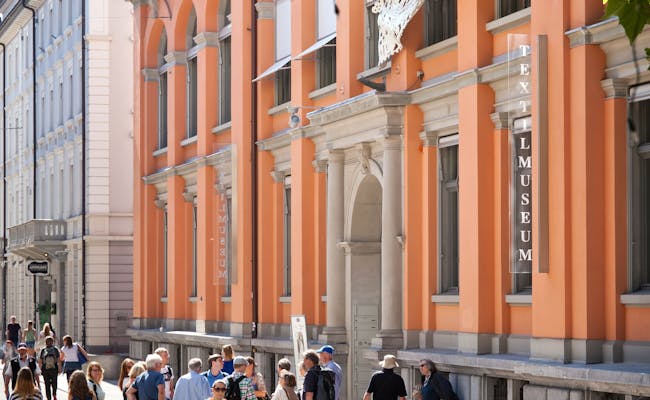 (Photo: Lake Constance Tourism)
(Photo: Lake Constance Tourism)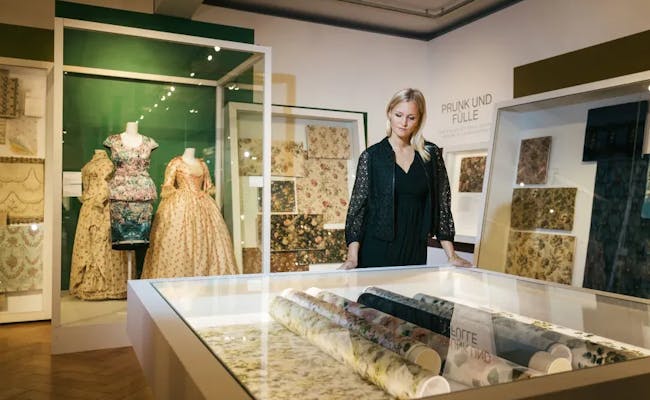 (Photo: MySwitzerland)
(Photo: MySwitzerland)Swiss Activities Tip: In several outlets you can buy the finest fabrics at attractive prices, should that fit into your pattern. To name a few examples, there is the Stoffladen Walser, the Fabrikladen Bischoff or the Jakob Schläpfer warehouse outlet.
Apart from the botanical garden and the textile museum, the city of St. Gallen has various other museums to offer for every taste. Among the best known are certainly the Museum of Nature, the Abbey Library, the Museum of Culture and Ethnology or the Museum of Art. All these candidates and more can be found in this compilation of museums.
The entrance fee is in most cases 12.- CHF for adults. However, if you have a Swiss museum pass, all these places are free for you.

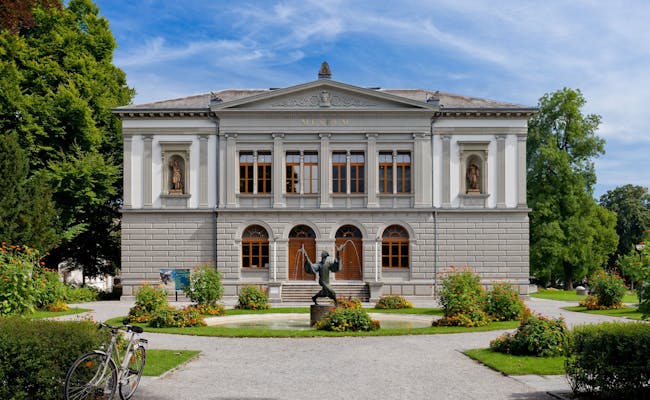 (Photo: Lake Constance Tourism)
(Photo: Lake Constance Tourism)After Schaffhausen, St. Gallen is the city with the second highest number of oriels. 111 ornate oriels adorn the buildings of the city center. They are equipped with all kinds of ornaments, which demonstrate power and influence.
So it's worthwhile, while strolling through St. Gallen, to let your eyes wander upwards every now and then and see what kind of curiosity is hanging over your head at the moment.
For those really interested in oriels, there is a specially created city tour of magnificent oriels in St. Gallen on the subject. Which leads us seamlessly to the next reason to visit St. Gallen.
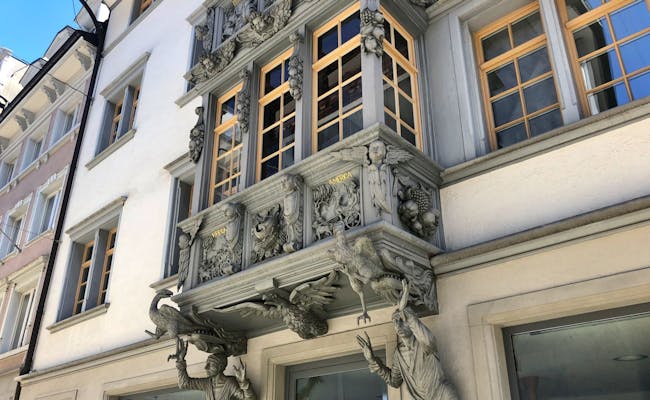 In St. Gallen, you can find 111 bay windows.
In St. Gallen, you can find 111 bay windows.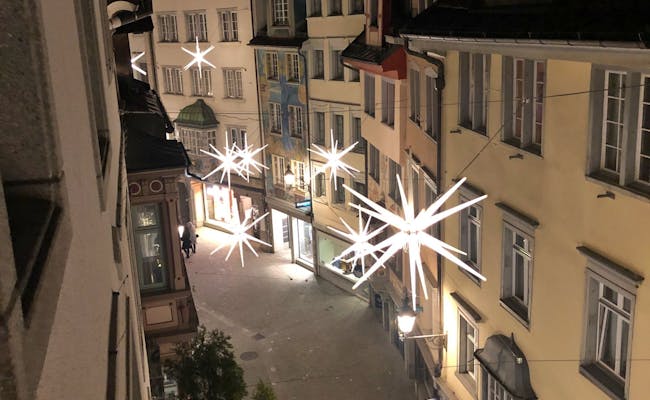 (Photo: Seraina Zellweger)
(Photo: Seraina Zellweger)Even if St. Gallen cannot boast a Trevi fountain like Rome, there are still some impressive fountains decorated with artistic sculptures scattered throughout the city. There are over 100 of them that characterize the cityscape of St. Gallen.
One of the most famous is undoubtedly the Broderbrunnen, which belongs to the Swiss inventory of cultural assets of national importance. You will come across it when you are traveling between the train station and the center of the old town and cross the street to Multergasse after the Red Square.
But you also can't miss the juggler in front of the art museum or the Gallus fountain on Gallusplatz.
If you keep an eye out during your visit to St. Gallen, you will discover a wide variety of fountains in sometimes unexpected places. Even if you are not looking for a way to fill up your water bottle.
Swiss Activities Tip: In Switzerland, you can fill up your water bottle at almost every public fountain. So there is no need to constantly buy water at the supermarket.
 Broder Fountain in St. Gallen
Broder Fountain in St. Gallen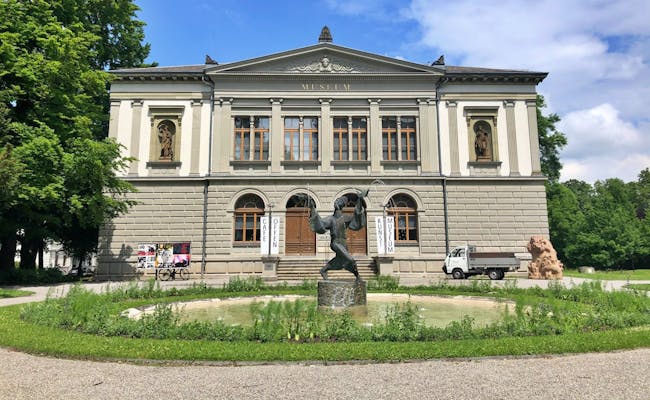 Juggler Fountain in front of the Art Museum in St. Gallen
Juggler Fountain in front of the Art Museum in St. GallenGuided tours exist in every city. They are a wonderful way to dive into the history of a place, learn more about the historical background and ask questions right away. But hold on now. In St. Gallen you have the choice between 38 (!!!) different city tours.
Quite a lot for a city with just under 80,000 inhabitants.
An overview of all guided tours can be found at Guided tours in St. Gallen. The thematic tours, which focus on a certain topic, always catch the eye on the website. For example, you have the opportunity to go on a voyage of discovery with a maid from the 16th century or to learn more about the medical history of the city of St. Gallen.
Art lovers, treasure hunters and bay window fanatics will also get their money's worth.
With such an immense choice, a guided tour of the city is almost a must.
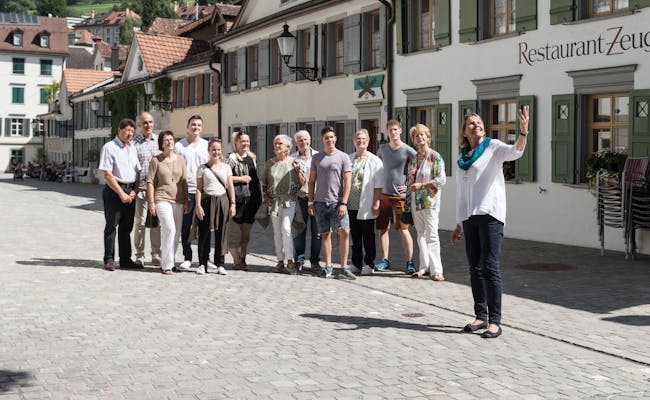 (Photo: Bodensee Tourism)
(Photo: Bodensee Tourism)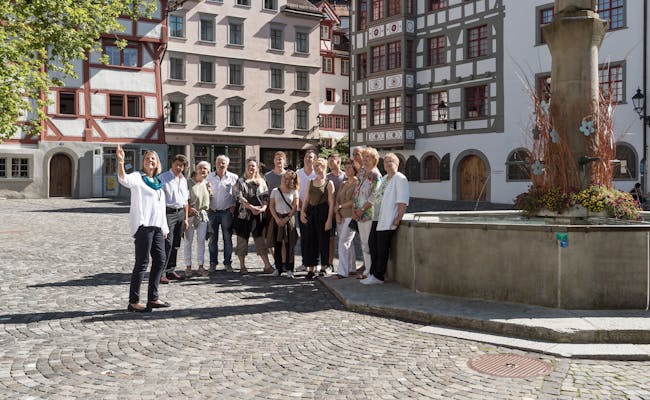 (Photo: Lake Constance Tourism)
(Photo: Lake Constance Tourism)Yes, St. Gallen has a "Red Square" and no, it is not the same as in Moscow.
The Red Square in St. Gallen is an art project also known as "Stadtlounge". The square was created in collaboration with the artist Pipilotti Rist and the architect Carlos Martinez and is located around the Raiffeisenbank along Schreinerstrasse. By the way, it can be easily recognized at first glance on Google Maps.
The St. Gallen lounge is equipped with sofas, chairs, tables, loungers and even a Porsche, which is especially popular with children for playing. The whole thing is covered with red rubber granules, which is supposed to give you the feeling of a carpet.
Swiss Activities Tip: The square is worth a visit during the daytime on the one hand, but also after dusk. The floating light bodies illuminate the square with their colored light and create a romantic atmosphere.
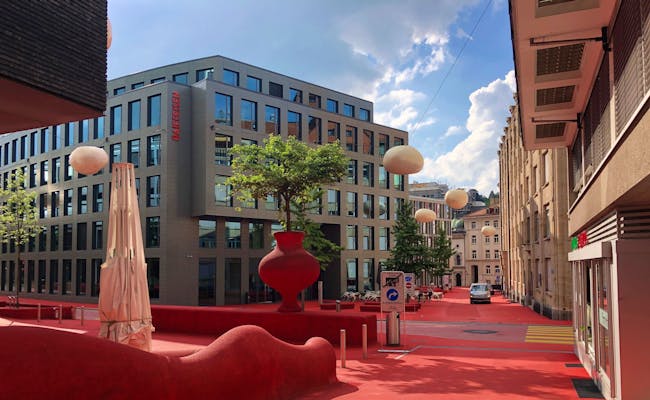 (Photo: Seraina Zellweger)
(Photo: Seraina Zellweger)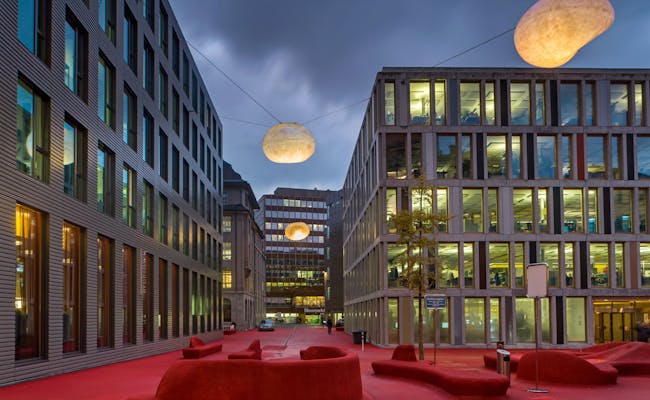 (Photo: Lake Constance Tourism)
(Photo: Lake Constance Tourism)In a world where the corona pandemic is over or hasn't happened yet, many great festivals take place in St. Gallen every year. Be it the famous Open Air St. Gallen in July, the entertaining Buskers Festival in spring or the legendary OLMA (fair for agriculture and food) in autumn.
You can find an overview of the upcoming festivals and markets on the website St Gallen - Messen, Märkte, Festivals of the city of St. Gallen. My personal favorite is the Buskers Festival, where numerous street artists from all over the world present their performances. The city feels like a big open-air circus during this time.
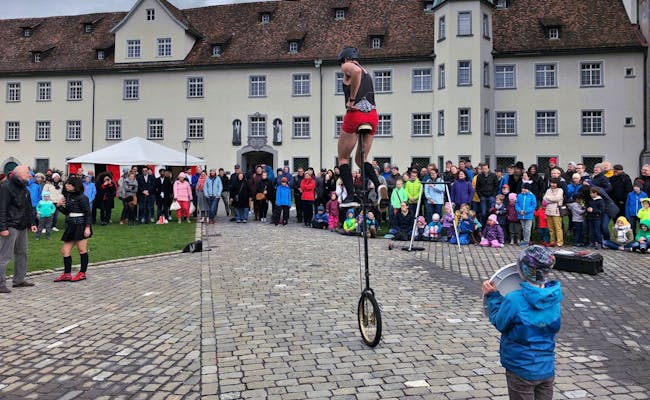 Open-Air Circus Juggler Festival
Open-Air Circus Juggler Festival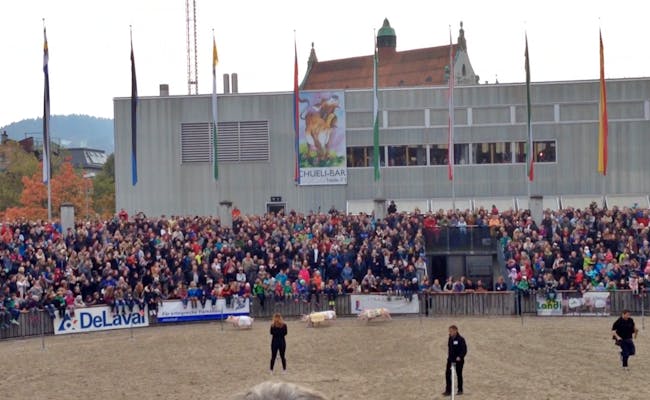 Legendary Pig Race at Olma
Legendary Pig Race at OlmaHardly any other art object divides the people of eastern Switzerland as much as the new station clock above the arrivals hall. Proponents admire the flashing work of art, while opponents are upset that they first have to study mathematics to be able to read the time.
The binary station clock is really limited in its suitability for everyday use. If you want to briefly check the time during your sprint to the next train, it really doesn't come to your rescue. Unless you have studied its principle in advance on the specially created website Bahnhofsuhr St Gallen and recognize the time at a glance.
However, if you have enough time and enjoy a little puzzle, be sure to stand in front of the controversial clock for a few minutes and try to figure out what time it is using the binary code.
_Swiss Activities Tip: The best place to start reading the clock is at the top line, which represents the hours. There is the least movement and you have time to get used to the principle before you move on to the minutes or even seconds
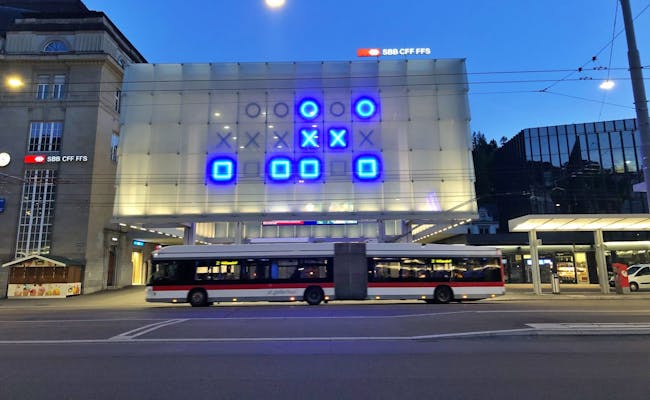 Can you read the time on this binary station clock?
Can you read the time on this binary station clock?The Lokremise St. Gallen was built over 100 years ago and was originally a depot for the maintenance of steam locomotives. With its 21 locomotive stands and approximately 80 meters in diameter, the Lokremise is the largest circular depot in Switzerland.
However, steam locomotives are no longer maintained here today. Instead, the depot was converted into a cultural center in 2010, which today enjoys great popularity among the people of St. Gallen. It can be rented for events and is a regular venue for theater performances, art exhibitions and even movies.
The stylishly furnished restaurant offers a varied French menu for the upper budget. Various indoor and outdoor seating areas in the immediate vicinity of the St. Gallen main train station invite you to linger.
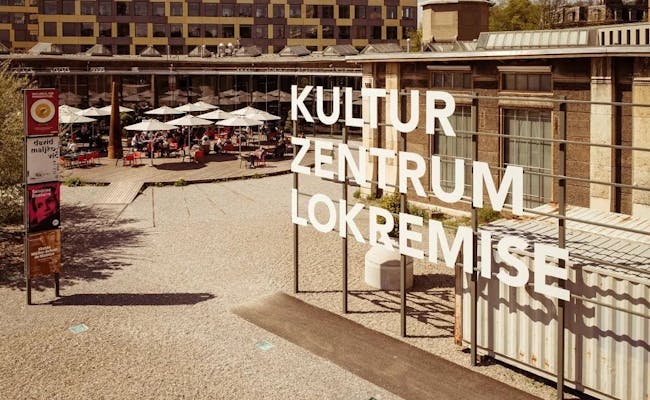 (Photo: MySwitzerland)
(Photo: MySwitzerland)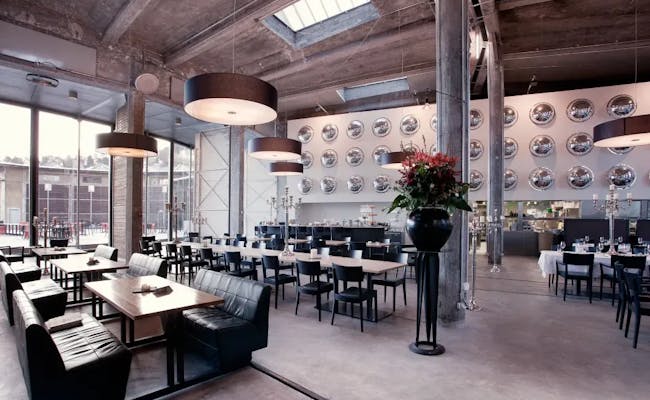 (Photo: MySwitzerland)
(Photo: MySwitzerland)The people of St. Gallen are mighty proud of their Bratwurst in St Gallen. You can enjoy it on almost every corner of the city and especially during the children's festival, which takes place every three years, and during the OLMA, it is consumed in great quantities.
Should you care to live in peace with the people of St. Gallen, however, you must remember one thing. Reaching for the mustard tube or even the ketchup bottle is taboo here. It is considered culinarily backward and even dishonorable. The argument: A St. Gallen bratwurst is so delicious on its own that any addition interferes with its enjoyment.
One can argue about that. However, it is such a strong unwritten law that it is best to stick to it.
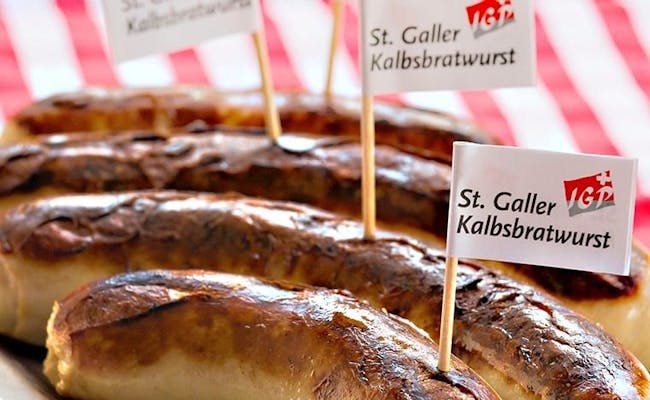 (Photo: MySwitzerland)
(Photo: MySwitzerland) (Photo: MySwitzerland)
(Photo: MySwitzerland)Whoever thinks of Biber often has the Appenzeller Biber, known throughout Switzerland, in mind. But not only the Appenzellers, also the St. Galleners have the delicious honey pastry filled with almond paste in their assortment. What the Bratwurst is for the butchers of St. Gallen, the Biber is for the bakers. Both specialties are known far beyond the canton's borders.
The Appenzeller is actually hardly different from the St. Gallen Biber. The differences are not so much between the cantons, but rather between the individual bakeries. Each has its own recipe and each Biber therefore tastes slightly different. But they are all undoubtedly delicious.
While the subjects of the Appenzell beavers are often characterized by cows, alpine processions, traditionally dressed alpine dairymen or the Alpstein mountains, the St. Gallen beaver is enthroned by the monastery or the abbey library.
On your tour through the old town of St. Gallen, you will pass numerous bakeries that present their beavers in their shop windows. Since you can't make a wrong choice, if you have a spontaneous attack of hunger for something sweet, I recommend going to the nearest available bakery to treat yourself to a piece of this St. Gallen specialty.
The Zeughaus restaurant not only serves wonderful cordonbleus at a very decent price, it is also located in a special place. The row of houses where the restaurant is located is directly attached to the former city wall. From the front it looks like half a house and when you are inside the building, you notice how long and narrow the restaurant is.
Whether it's for a delicious cordon bleu or a funny photo of the front, walking through Zeughausgasse next to Laurenzenkirche should not be missed during a visit to St. Gallen.
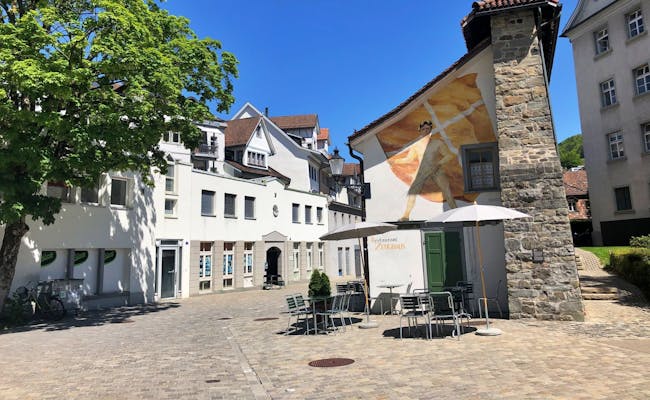 The restaurant Zeughaus is attached to the old city wall of St. Gallen.
The restaurant Zeughaus is attached to the old city wall of St. Gallen.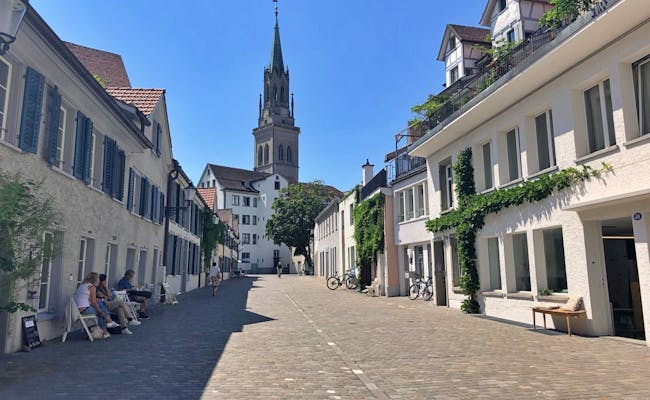 (Photo: Seraina Zellweger)
(Photo: Seraina Zellweger)Culinarily, the city of St. Gallen has a lot to offer besides cordon bleus at the Zeughaus and the legendary bratwurst. Whether you're looking for a delicious Swiss Rösti, a Vietnamese Pho, a wood-fired pizza or a chocolatey dessert - you'll find it here.
So as not to overdo this article, I'll limit myself to my 12 favorites for now:
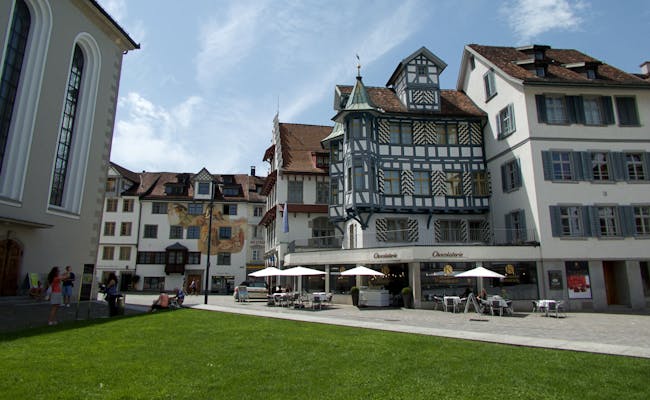 The Kölbener Chocolatier at Gallusplatz leaves no dessert wishes unfulfilled.
The Kölbener Chocolatier at Gallusplatz leaves no dessert wishes unfulfilled. (Photo: Seraina Zellweger)
(Photo: Seraina Zellweger)There’s some debate about whether the Säntispark really belongs to St. Gallen or not. What’s clear is that it’s only 15 minutes from the city center, located in Abtwil, making it a great destination for families or when the weather’s not so nice.
Whether you’re looking for a sauna session, a relaxing massage, a splash in the Säntispark spa area, an adrenaline-pumping slide at the water park, or engaging in one of the many recreational activities, you’ll find it all at Säntispark.
If you decide to stay longer in Abtwil, there’s the Hotel Säntispark, which offers its guests free entry to the sauna and spa area.
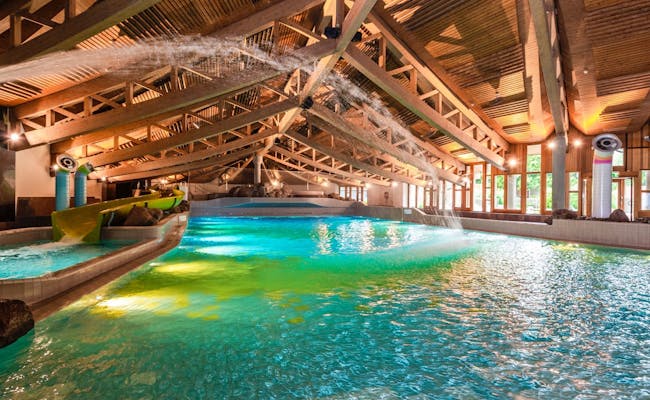 (Photo: MySwitzerland)
(Photo: MySwitzerland)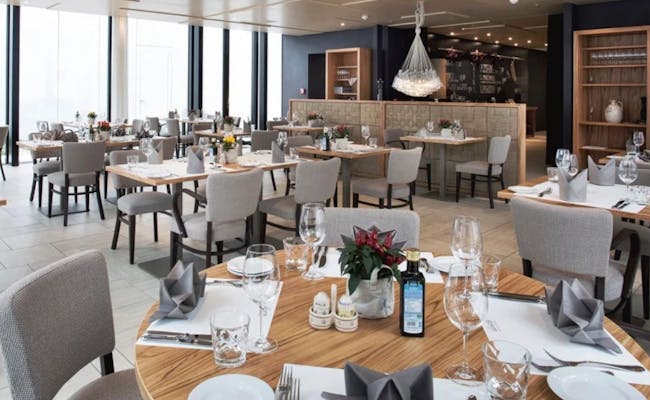 (Photo: MySwitzerland)
(Photo: MySwitzerland)Not just for an afternoon at Säntispark, St. Gallen is located in a diverse region that offers great options for extended day trips. There are numerous excursion opportunities, and you’ll find plenty of inspiration on the St. Gallen – Bodensee Tourism website. So, if you have enough time and don’t want to spend your entire stay in St. Gallen, there are many options for exciting discovery tours.
Here are some recommendations we’d like to share:
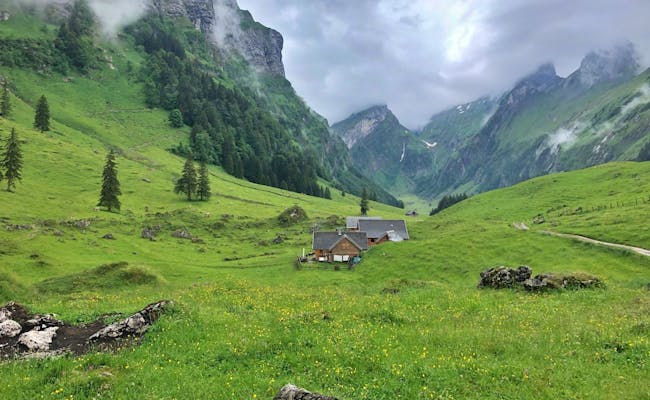 The Alpstein is a hiking area near St. Gallen.
The Alpstein is a hiking area near St. Gallen.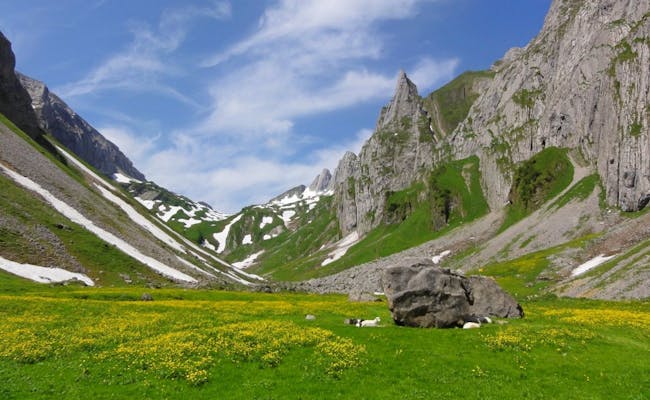 Hiking in the Alpstein (Photo: Seraina Zellweger)
Hiking in the Alpstein (Photo: Seraina Zellweger)The dense public transportation network in Switzerland makes it easy for visitors and locals alike to explore every corner of the country without a private vehicle.
Even though St. Gallen isn't centrally located from a Swiss perspective, the city can be easily reached. Three to four trains run hourly to and from Zurich, and the direct and scenic Voralpen Express connects St. Gallen with Lucerne. There are also reliable train connections towards Chur, Austria, and Germany.
So there's no reason to declare St. Gallen's remoteness as a reason for not visiting. You'd need to have a severe phobia of bay windows or binary train station clocks for that.
Let’s be honest.
When you chat with someone who’s been to Switzerland and ask them about the places they visited, you often hear a list like: Interlaken, Lucerne, Zermatt, and Zurich. Maybe Geneva too.
St. Gallen usually doesn’t make this list.
On one hand, that’s a shame because the city has so much to offer. On the other hand, it means you get to visit a place that isn’t overrun by tourists. Anyone who has tried to navigate their way across the Chapel Bridge in Lucerne after ten tour buses arrive knows exactly what I mean.
But even the center of Interlaken or Zermatt loses some of its charm due to the high number of visitors.
In St. Gallen you don't have this problem. As an insider tip on the eastern edge of Switzerland, here you can immerse yourself in a city where the locals stay and enjoy their city far away from overwhelming tourist crowds. And if a group from distant lands does arrive, they'll really stand out in the hustle and bustle of the local population.
If you too want to be an exotic, don't miss St. Gallen. The city of Gallen awaits you.
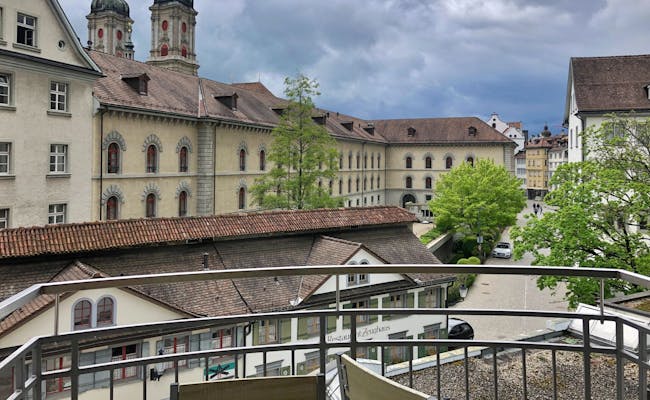 (Photo: Seraina Zellweger)
(Photo: Seraina Zellweger)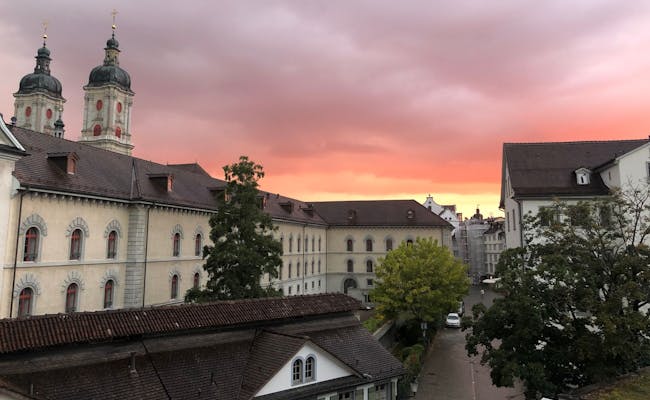 (Photo: Seraina Zellweger)
(Photo: Seraina Zellweger)